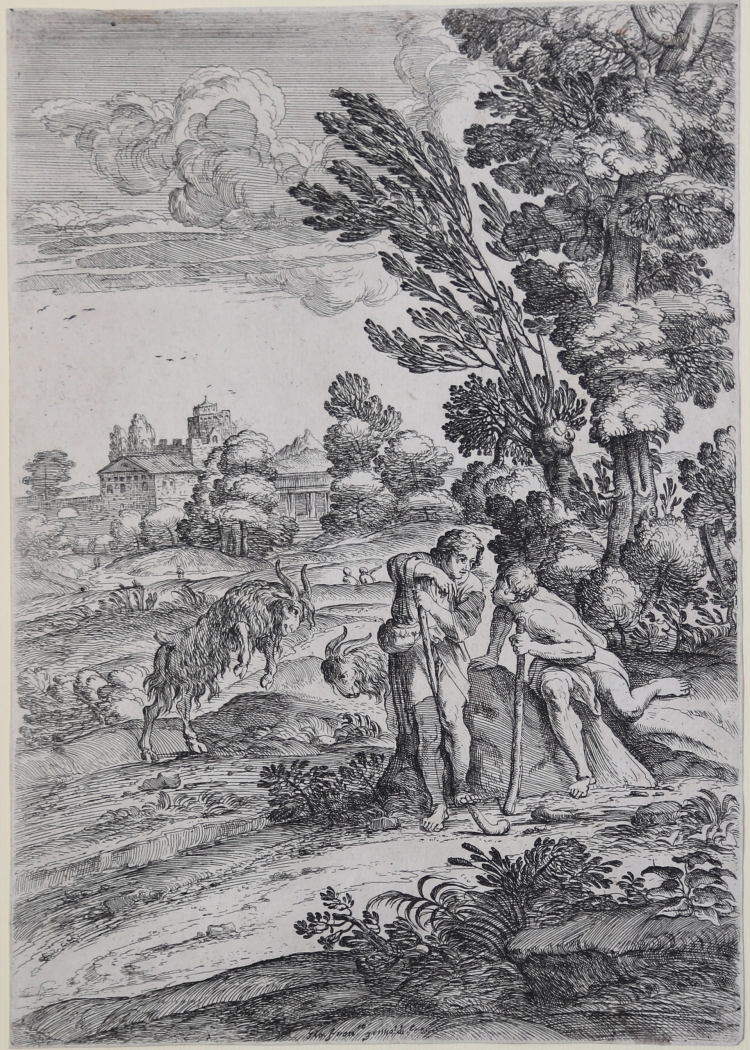




| Reference: | S24513 |
| Author | Giovanni Francesco GRIMALDI detto "il Bolognese" |
| Year: | 1650 ca. |
| Measures: | 219 x 309 mm |



| Reference: | S24513 |
| Author | Giovanni Francesco GRIMALDI detto "il Bolognese" |
| Year: | 1650 ca. |
| Measures: | 219 x 309 mm |
Etching, 1650 circa, signed on lower centre plate.
Magnificent work, rich in shades, printed on contemporary laid paper, trimmer to platemark or with very thin margins, in excellent condition. Known as “il Bolognese”, Grimaldi was probably born in the city around 1606 and, as his late production suggests, he was deeply influenced by his early contact with Carracci.
Giovanni Francesco Grimaldi (Bologna, 1606 - Rome, November 28, 1680) was an Italian painter and architect. Trained initially within the Carracci family, who represented one of the main schools of painting in Bologna at the time, he then went to Rome while still young. Here he would work for a long time for patrons such as Cardinal Francesco Albani and the Santacroce family. In 1638 he married Eleonora Aloisi, daughter of the Bolognese painter Baldassarre (called the Galanino), who died in the same year and was related to the Carracci through his wife. Also in 1638 he painted the facade of the Palazzo Poli in Rome on the occasion of the visit to the city of Johann Anton prince of Eggenberg, sent by Emperor Ferdinand III of Habsburg. He collaborated with Alessandro Algardi on several occasions, including in the staging of the funeral of Marquis Ludovico Facchinetti, Bologna's ambassador to the papal court, who died in January 1644. He also worked on other apparatuses for festivals, funeral honors, and plays between 1640 and 1671. His prestige as an artist in Roman circles led him to enter the prestigious Accademia di San Luca as early as 1635 and to hold various positions within that institution (Rector in 1656) until the highest position of Prince in 1666 after having renounced it in 1658. In 1657 he also entered the Congregation of the Virtuosi at the Pantheon. In 1648 he went, at the invitation of Cardinal Julius Mazarin, to Paris to paint some rooms in the Louvre Palace.
Grimaldi produced over fifty landscape etchings, all strongly influenced by the landscape formula of Annibale Carracci and Domenichino. His prints, as well as his paintings and drawings of views, are characterized by an extremely regular and controlled approach to nature, emphasizing horizontal and vertical lines and planes. In the manner of his Bolognese models, Grimaldi often used protruding rock or earth masses, strategically placed rows of trees, and architectures placed in planes to arrange his organizational scheme.
|
Bartsch 14.
|
Giovanni Francesco GRIMALDI detto "il Bolognese" (Bologna 1606 – Roma 1680)
|
Italian painter, printmaker, draughtsman and architect. He was an accomplished fresco painter, whose decorative landscapes were popular with such leading Roman families as the Santacroce, the Pamphili and the Borghese; his many landscape etchings and drawings spread the influence of 17th-century Bolognese landscape throughout Europe. After studying in Bologna in the circle of the Carracci, he arrived in Rome c. 1626 and by 1635 was already a member of the Accademia di S Luca and associated with the circle of artists working with Pietro da Cortona. Sometime between 1635 and 1640 he collaborated with François Perrier and Giovanni Ruggieri on the decoration of the gallery in the Palazzo Peretti–Amalgia, Rome; the vault, which was probably designed by Grimaldi, was modelled on Cortona’s gallery in the Villa Sacchetti at Castelfusano. In 1640–41, again inspired by the Villa Sacchetti, Grimaldi frescoed the vault of the great hall of the Palazzo Santacroce ai Catinari, Rome. In the centre, an allegorical composition, the Triumph of Authority over Time, celebrates the Santacroce family, and surrounding this are four compositions of Old Testament scenes set in landscapes deeply influenced by the Carracci tradition, in which trees form a natural frame for views across varied terrain with distant figures. Illusionism is limited to the allegorical figures set against the sky at the corners of the vault.
|
|
Bartsch 14.
|
Giovanni Francesco GRIMALDI detto "il Bolognese" (Bologna 1606 – Roma 1680)
|
Italian painter, printmaker, draughtsman and architect. He was an accomplished fresco painter, whose decorative landscapes were popular with such leading Roman families as the Santacroce, the Pamphili and the Borghese; his many landscape etchings and drawings spread the influence of 17th-century Bolognese landscape throughout Europe. After studying in Bologna in the circle of the Carracci, he arrived in Rome c. 1626 and by 1635 was already a member of the Accademia di S Luca and associated with the circle of artists working with Pietro da Cortona. Sometime between 1635 and 1640 he collaborated with François Perrier and Giovanni Ruggieri on the decoration of the gallery in the Palazzo Peretti–Amalgia, Rome; the vault, which was probably designed by Grimaldi, was modelled on Cortona’s gallery in the Villa Sacchetti at Castelfusano. In 1640–41, again inspired by the Villa Sacchetti, Grimaldi frescoed the vault of the great hall of the Palazzo Santacroce ai Catinari, Rome. In the centre, an allegorical composition, the Triumph of Authority over Time, celebrates the Santacroce family, and surrounding this are four compositions of Old Testament scenes set in landscapes deeply influenced by the Carracci tradition, in which trees form a natural frame for views across varied terrain with distant figures. Illusionism is limited to the allegorical figures set against the sky at the corners of the vault.
|